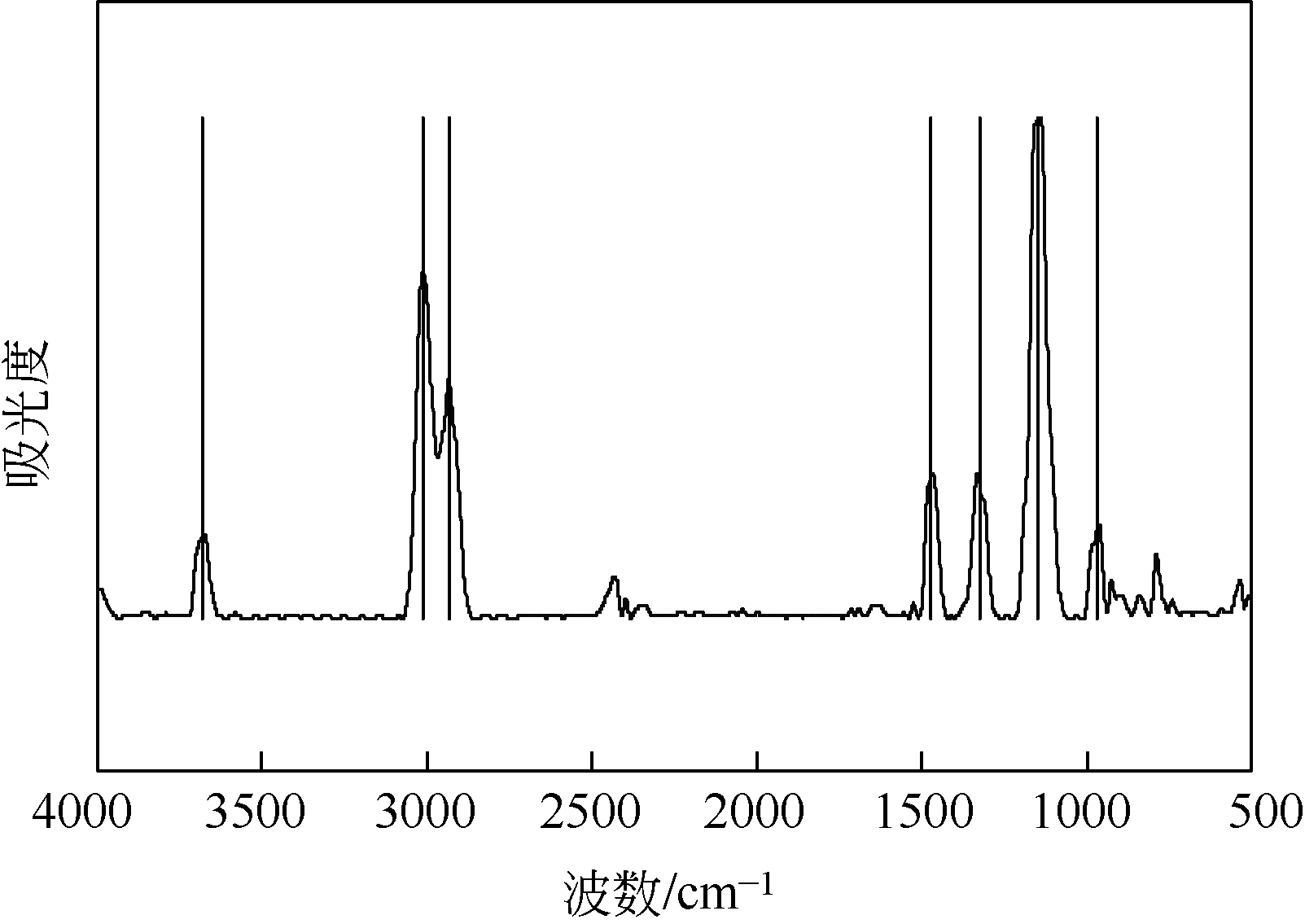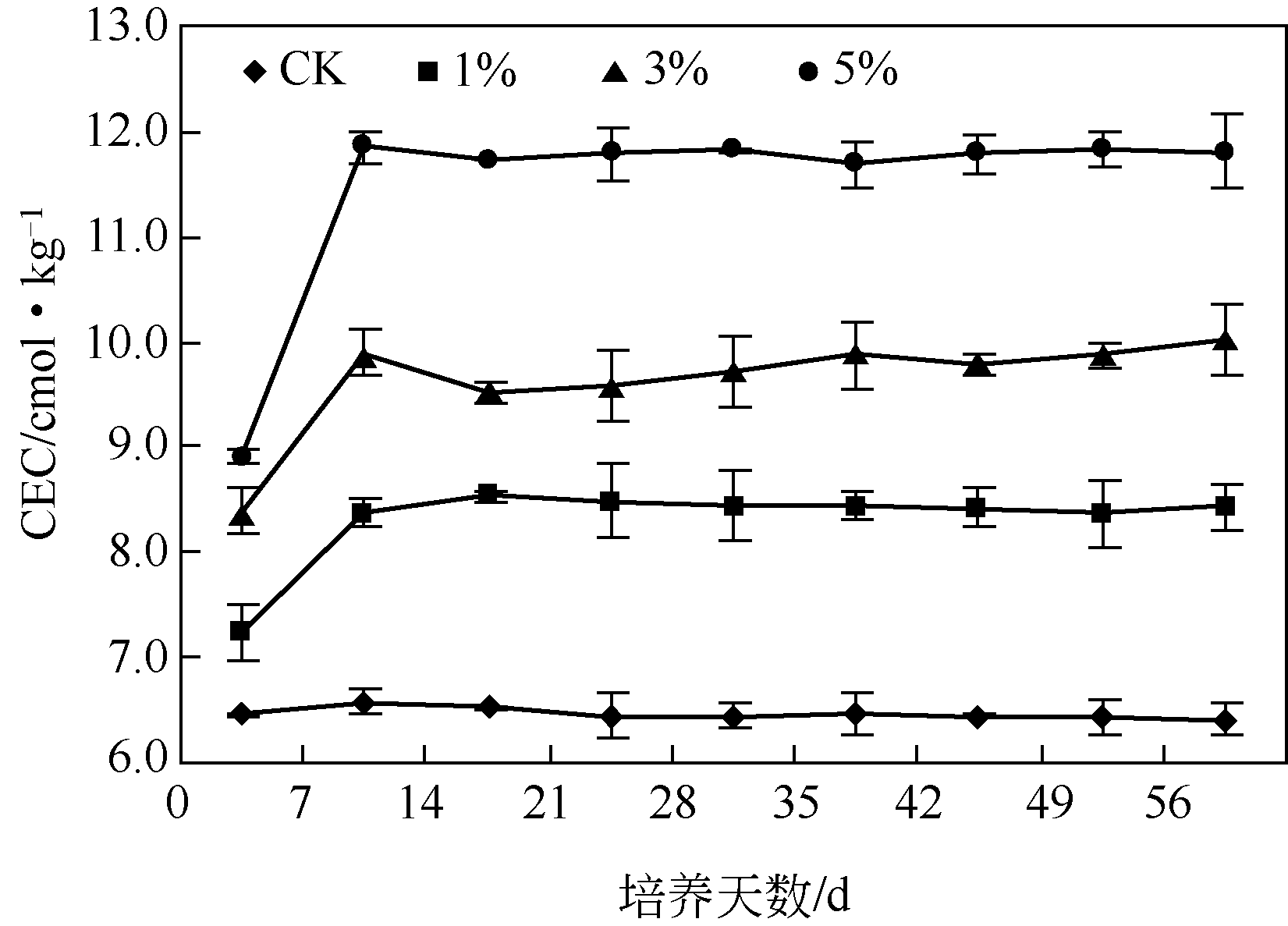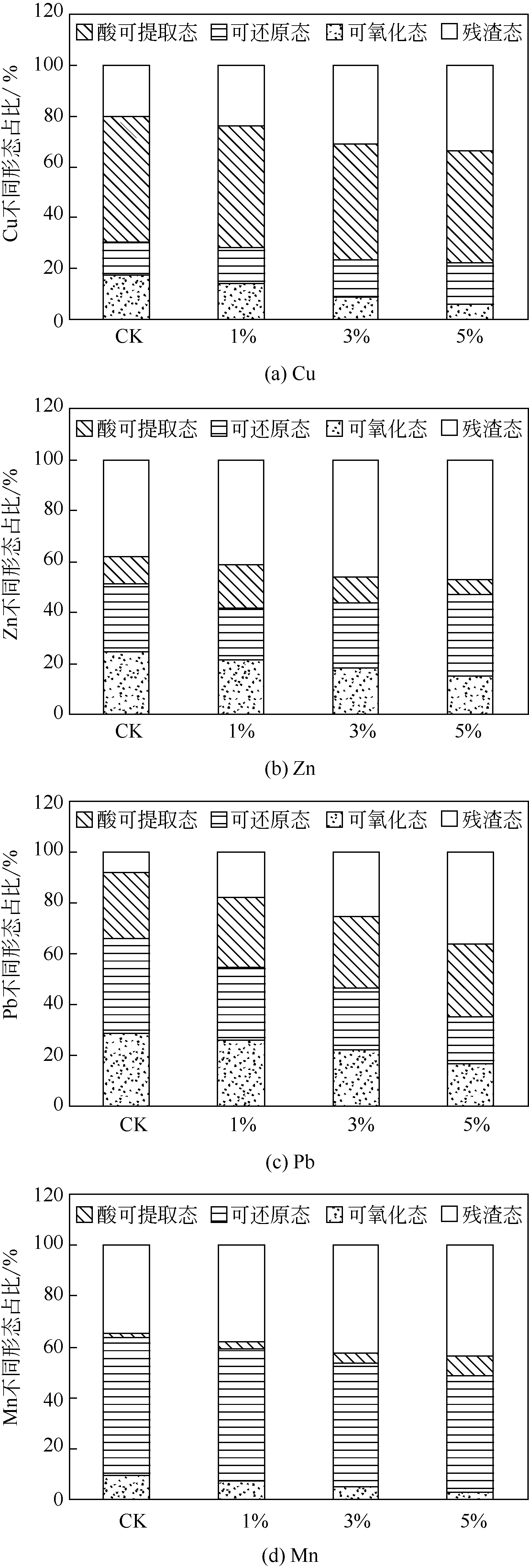Chemical Industry and Engineering Progress ›› 2019, Vol. 38 ›› Issue (06): 2977-2985.DOI: 10.16085/j.issn.1000-6613.2018-1732
• Resources and environmental engineering • Previous Articles Next Articles
Effect of biochar on the bioavailability and transformation of heavy metals in soil of mining area
Zhe WANG( ),Zhansheng MI,Chunli ZHENG(
),Zhansheng MI,Chunli ZHENG( ),Weiping LI,Weida WANG,Huimin WANG
),Weiping LI,Weida WANG,Huimin WANG
- School of Energy and Environment, Inner Mongolia of Science and Technology, Baotou 014010, Inner Mongolia, China
-
Received:2018-08-27Online:2019-06-05Published:2019-06-05 -
Contact:Chunli ZHENG
生物炭对矿区土壤重金属有效性及形态的影响
- 内蒙古科技大学能源与环境学院,内蒙古 包头 014010
-
通讯作者:郑春丽 -
作者简介:王哲(1979—),女,博士研究生,副教授,主要研究方向为矿区污染土壤修复。E-mail:<email>wz0478@163.com</email>。 -
基金资助:国家自然科学基金(41867061);内蒙古自治区自然科学基金(2016MS0222)
CLC Number:
Cite this article
Zhe WANG, Zhansheng MI, Chunli ZHENG, Weiping LI, Weida WANG, Huimin WANG. Effect of biochar on the bioavailability and transformation of heavy metals in soil of mining area[J]. Chemical Industry and Engineering Progress, 2019, 38(06): 2977-2985.
王哲, 宓展盛, 郑春丽, 李卫平, 王维大, 王慧敏. 生物炭对矿区土壤重金属有效性及形态的影响[J]. 化工进展, 2019, 38(06): 2977-2985.
share this article
Add to citation manager EndNote|Ris|BibTeX
URL: https://hgjz.cip.com.cn/EN/10.16085/j.issn.1000-6613.2018-1732
| pH | CEC/cmol·kg-1 | 含水率/% | 灰分/% | 产率/% | 比表面积/m2·g-1 | 孔容/cm3·g-1 | Cu/mg·kg-1 | Zn/mg·kg-1 | Pb/mg·kg-1 | Mn/mg·kg-1 |
|---|---|---|---|---|---|---|---|---|---|---|
| 9.85 | 38.6 | 5.41 | 22.81 | 33.54 | 7.89 | 0.0059 | 0.16 | 0.29 | 0.18 | 0.33 |
| pH | CEC/cmol·kg-1 | 含水率/% | 灰分/% | 产率/% | 比表面积/m2·g-1 | 孔容/cm3·g-1 | Cu/mg·kg-1 | Zn/mg·kg-1 | Pb/mg·kg-1 | Mn/mg·kg-1 |
|---|---|---|---|---|---|---|---|---|---|---|
| 9.85 | 38.6 | 5.41 | 22.81 | 33.54 | 7.89 | 0.0059 | 0.16 | 0.29 | 0.18 | 0.33 |
| 项目 | Cu有效态 | Zn有效态 | Pb有效态 | Mn有效态 |
|---|---|---|---|---|
| pH | -0.766① | -0.624① | -0.890① | 0.579② |
| CEC | -0.610① | -0.372② | -0.376① | -0.666① |
| 项目 | Cu有效态 | Zn有效态 | Pb有效态 | Mn有效态 |
|---|---|---|---|---|
| pH | -0.766① | -0.624① | -0.890① | 0.579② |
| CEC | -0.610① | -0.372② | -0.376① | -0.666① |
| 1 | CANDEIAS C , MELO R , ÁVILA P F , et al . Heavy metal pollution in mine-soil-plant system in S. Francisco de Assis-Panasqueira mine (Portugal)[J]. Applied Geochemistry, 2014, 44(3): 12-26. |
| 2 | 黄小娟, 江长胜, 郝庆菊 . 重庆溶溪锰矿区土壤重金属污染评价及植物吸收特征[J]. 生态学报, 2014, 34(15): 4201-4211. |
| HUANG X J , JIANG C S , HAO Q J . Assessment of heavy metal pollutions in soils and bioaccumulation of heavy metals by plants in Rongxi Manganese mineland of Chongqing[J]. Acta Ecologica Sinica, 2014, 34(15): 4201-4211. | |
| 3 | 徐粲然, 卢滇楠, 刘永民 . 生物钝化修复镉污染土壤研究进展[J]. 化工进展, 2014, 33(8): 2174-2179. |
| XU C R , LU D N , LIU Y M . Research advance in the biostabilization remediation of cadmium contaminated soil[J]. Chemical Industry and Engineering Progress, 2014, 33(8): 2174-2179. | |
| 4 | SUMAN RAJ D S , APARNA C , REKHA P , et al . Stabilization and solidification technologies for the remediation of contaminated soils and sediments: an overview[J]. Land Contamination and Reclamation, 2005, 13(1): 23-48. |
| 5 | 张小凯, 何丽芝, 陆扣萍, 等 . 生物质炭修复重金属及有机物污染土壤的研究进展[J]. 土壤, 2013, 45(6): 970-977. |
| ZHANG X K , HE L Z , LU K P , et al . Use of biochar for remediation of soils contaminated with heavy metals and organic pollutants: a review[J]. Soils, 2013, 45(6): 970-977. | |
| 6 | RIZWAN M S , IMTIAZ M , CHHAJRO M A , et al . Influence of pyrolytic and non-pyrolytic rice and castor straws on the immobilization of Pb and Cu in contaminated soil[J]. Environmental Technology, 2016, 37(21): 2679-2688. |
| 7 | 荆延德, 巩晨, 孙小银, 等 . 棉花、花生秸秆生物炭对棕壤中Cu(Ⅱ)运移的影响[J]. 水土保持通报, 2016, 36(3): 50-55. |
| JING Y D , GONG C , SUN X Y , et al . Effects of cotton and peanut straw biochar on Cu(Ⅱ) migration in brown soil[J]. Bulletin of Soil and Water Conservation, 2016, 36(3): 50-55. | |
| 8 | HOUBEN D , EVRARD L , SONNET P . Beneficial effects of biochar application to contaminated soils on the bioavailability of Cd, Pb and Zn and the biomass production of rapeseed (Brassica napus L.)[J]. Biomass & Bioenergy, 2013, 57(11): 196-204. |
| 9 | 张连科, 刘心宇, 王维大, 等 . 两种油料作物秸秆生物炭对土壤中铅的钝化修复[J]. 生态环境学报, 2018, 27(1): 166-173. |
| ZHANG L K , LIU X Y , WANG W D , et al . Passivation and remediation of lead in soil by biochar from two oil crops[J]. Journal of Ecology and Environment, 2018, 27(1): 166-173. | |
| 10 | FELLET G , MARMIROLI M , MARCHIOL L . Elements uptake by metal accumulator species grown on mine tailings amended with three types of biochar[J]. Science of the Total Environment, 2014, 468-469:598-608. |
| 11 | 段丽丽 . 白云鄂博矿区土壤重金属污染地球化学评价[J]. 山东理工大学学报(自然科学版), 2012, 26(6): 23-28. |
| DUAN L L . Pollution assessments of heavy metals in soils in the mining area of Bayan Obo[J]. Journal of Shandong University of Technology(Natural Science Edition) , 2012, 26(6): 23-28. | |
| 12 | 徐楠楠, 林大松, 徐应明, 等 . 玉米秸秆生物炭对Cd2+的吸附特性及影响因素[J]. 农业环境科学学报, 2014, 33(5): 958-964. |
| XU N N , LIN D S , XU Y M , et al . Adsorption of aquatic Cd2+ by biochar obtained from corn stover[J]. Journal of Agro-Environment Science, 2014, 33(5): 958-964. | |
| 13 | HOUBEN D , EVRARD L , SONNET P . Mobility, bioavailability and pH-dependent leaching of cadmium, zinc and lead in a contaminated soil amended with biochar[J]. Chemosphere, 2013, 92(11): 1450-1457. |
| 14 | XU X Y , CAO X D . Removal of Cu, Zn, and Cd from aqueous solutions by the dairy manure-derived biochar[J]. Environmental Science & Pollution Research, 2013, 20(1): 358-368. |
| 15 | 杨兰, 李冰, 王昌全, 等 . 改性生物炭材料对稻田原状和外源镉污染土钝化效应[J]. 环境科学, 2016, 37(9): 3562-3574. |
| YANG L , LI B , WANG C Q , et al . Effect of modified biochars on soil cadmium stabilization in paddy soil suffered from original or exogenous contamination[J]. Environmental Science, 2016, 37(9): 3562-3574. | |
| 16 | LUNDBERG B , SUNDQVIST B . A review of biochars’ potential role in the remediation, revegetation and restoration of contaminated soils[J]. Environmental Pollution, 2011, 159(12): 3269-3282. |
| 17 | 吴烈善, 曾东梅, 莫小荣, 等 . 不同钝化剂对重金属污染土壤稳定化效应的研究[J]. 环境科学, 2015, 36(1): 309-313. |
| WU L S , ZENG D M , MO X R , et al . Immobilization impact of different fixatives on heavy metals contaminated soil[J]. Environmental Science, 2015, 36(1): 309-313. | |
| 18 | BOLAN N , KUNHIKRISHNAN A , THANGARAJAN R , et al . Remediation of heavy metal(loid)s contaminated soils-to mobilize or to immobilize?[J]. Journal of Hazardous Materials, 2014, 266(4): 141-166. |
| 19 | 孙约兵, 王朋超, 徐应明, 等 . 海泡石对镉-铅复合污染钝化修复效应及其土壤环境质量影响研究[J]. 环境科学, 2014, 35(12): 4720-4726. |
| SUN Y B , WANG P C , XU Y M , et al . Immobilization remediation of Cd and Pb contaminated soil:remediation potential and soil environmental quality[J]. Environmental Science, 2014, 35(12): 4720-4726. | |
| 20 | WAGNER A , KAUPENJOHANN M . Suitability of biochars (pyro and hydrochars) for metal immobilization on former sewage field soils[J]. European Journal of Soil Science, 2014, 65(1): 139-148. |
| 21 | 高瑞丽, 唐茂, 付庆灵, 等 . 生物炭、蒙脱石及其混合添加对复合污染土壤中重金属形态的影响[J]. 环境科学, 2017, 38(1): 361-367. |
| GAO R L , TANG M , FU Q L , et al . Fractions transformation of heavy metals in compound contaminated soil treated with biochar, montmorillonite and mixed addition[J]. Environmental Science, 2017, 38(1): 361-367. | |
| 22 | MOHAMED I , ZHANG G S , LI Z G , et al . Ecological restoration of an acidic Cd contaminated soil using bamboo biochar application[J]. Ecological Engineering, 2015, 84: 67-76. |
| 23 | YIN D , WANG X , CHEN C , et al . Varying effect of biochar on Cd, Pb and As mobility in a multi-metal contaminated paddy soil[J]. Chemosphere, 2016, 152: 196-206. |
| 24 | LIANG J , YANG Z , TANG L , et al . Changes in heavy metal mobility and availability from contaminated wetland soil remediated with combined biochar-compost[J]. Chemosphere, 2017, 181: 281-288. |
| 25 | YANG X , LIU J , MCGROUTHER K , et al . Effect of biochar on the extractability of heavy metals (Cd, Cu, Pb, and Zn) and enzyme activity in soil[J]. Environmental Science & Pollution Research, 2016, 23(2): 974-984. |
| 26 | 高译丹, 梁成华, 裴中健, 等 . 施用生物炭和石灰对土壤镉形态转化的影响[J]. 水土保持学报, 2014, 28(2): 258-261. |
| GAO Y D , LIANG C H , PEI Z J , et al . Effects of biochar and lime on the fraction transform of cadmium in contaminated soil[J]. Journal of Soil and Water Conservation, 2014, 28(2): 258-261. | |
| 27 | 高彦鑫, 冯金国, 唐磊, 等 . 密云水库上游金属矿区土壤中重金属形态分布及风险评价[J]. 环境科学, 2012, 33(5): 1707-1717. |
| GAO Y X , FENG J G , TANG L , et al . Fraction distribution and risk assessment of heavy metals in iron and gold mine soil of Miyun reservoir upstream[J]. Environmental Science, 2012, 33(5): 1707-1717. | |
| 28 | 刘晶晶, 杨兴, 陆扣萍, 等 . 生物质炭对土壤重金属形态转化及其有效性的影响[J]. 环境科学学报, 2015, 35(11): 3679-3687. |
| LIU J J , YANG X , LU K P , et al . Effect of bamboo and rice straw biochars on the transformation and bioavailability of heavy metals in soil[J]. Acta Scientiae Circumstantiae, 2015, 35(11): 3679-3687. | |
| 29 | RIZWAN M S , IMTIAZ M , HUANG G Y , et al . Immobilization of Pb and Cu in polluted soil by superphosphate, multi-walled carbon nanotube, rice straw and its derived biochar[J]. Environmental Science and Pollution Research, 2016, 23 (15) : 15532-15543. |
| 30 | 高瑞丽, 朱俊, 汤帆, 等 . 水稻秸秆生物炭对镉、铅复合污染土壤中重金属形态转化的短期影响[J]. 环境科学学报, 2016, 36(1): 251-256. |
| GAO R L , ZHU J , TANG F , et al . Fractions transformation of Cd, Pb in contaminated soil after short-term application of rice straw biochar[J]. Acta Scientiae Circumstantiae, 2016, 36(1): 251-256. | |
| 31 | JIANG J , XU R , JIANG T , et al . Immobilization of Cu(Ⅱ), Pb(Ⅱ) and Cd(Ⅱ) by the addition of rice straw derived biochar to a simulated polluted Ultisol[J]. Journal of Hazardous Materials, 2012, 229: 145-150. |
| 32 | LIANG Y , CAO X , ZHAO L , et al . Biochar- and phosphate-induced immobilization of heavy metals in contaminated soil and water: implication on simultaneous remediation of contaminated soil and groundwater[J]. Environmental Science & Pollution Research, 2014, 21(6): 4665-4674. |
| 33 | 吴曼, 徐明岗, 徐绍辉, 等 . 有机质对红壤和黑土中外源铅镉稳定化过程的影响[J]. 农业环境科学学报, 2011, 30(3): 461-467. |
| WU M , XU M G , XU S H , et al . Effects of organic matter on the stabilization process of added cadmium and lead in red soil and black soil[J]. Journal of Agro-environment Science, 2011, 30(3): 461-467. | |
| 34 | UCHIMIYA M , KLASSON K T , WARTELLE L H , et al . Influence of soil properties on heavy metal sequestration by biochar amendment: 1. Copper sorption isotherms and the release of cations[J]. Chemosphere, 2011, 82(10): 1431-1437. |
| 35 | SAHA U K , TANIGUCHI S , SAKURAI K . Adsorption behavior of cadmium, zinc, and lead on hydroxyaluminum and hydroxyaluminosilicate-montmorillonite complexes[J]. Soil Science Society of America Journal, 2001, 65(3): 694-703. |
| 36 | 林青, 徐绍辉 . 土壤中重金属离子竞争吸附的研究进展[J]. 土壤, 2008, 40(5): 706-711. |
| LIN Q , XU S H . A review on competitive adsorption of heavy metals in soils[J]. Soils, 2008, 40(5): 706-711. |
| [1] | DAI Huantao, CAO Lingyu, YOU Xinxiu, XU Haoliang, WANG Tao, XIANG Wei, ZHANG Xueyang. Adsorption properties of CO2 on pomelo peel biochar impregnated by lignin [J]. Chemical Industry and Engineering Progress, 2023, 42(S1): 356-363. |
| [2] | LI Shilin, HU Jingze, WANG Yilin, WANG Qingji, SHAO Lei. Research progress in separation and extraction of high value components by electrodialysis [J]. Chemical Industry and Engineering Progress, 2023, 42(S1): 420-429. |
| [3] | XU Chunshu, YAO Qingda, LIANG Yongxian, ZHOU Hualong. Research progress on functionalization strategies of covalent organic frame materials and its adsorption properties for Hg(Ⅱ) and Cr(Ⅵ) [J]. Chemical Industry and Engineering Progress, 2023, 42(S1): 461-478. |
| [4] | LI Weihua, YU Qianwen, YIN Junquan, WU Yinkai, SUN Yingjie, WANG Yan, WANG Huawei, YANG Yufei, LONG Yuyang, HUANG Qifei, GE Yanchen, HE Yiyang, ZHAO Lingyan. Leaching behavior of heavy metals from broken ton bags filled with fly ash in acid rain environment [J]. Chemical Industry and Engineering Progress, 2023, 42(9): 4917-4928. |
| [5] | LI Zhiyuan, HUANG Yaji, ZHAO Jiaqi, YU Mengzhu, ZHU Zhicheng, CHENG Haoqiang, SHI Hao, WANG Sheng. Characterization of heavy metals during co-pyrolysis of sludge with PVC [J]. Chemical Industry and Engineering Progress, 2023, 42(9): 4947-4956. |
| [6] | WANG Haoran, YIN Quanyu, FANG Ming, HOU Jianlin, LI Jun, HE Bin, ZHANG Mingyue. Optimization of near critical-water treatment process of tobacco stems [J]. Chemical Industry and Engineering Progress, 2023, 42(9): 5019-5027. |
| [7] | WANG Xin, WANG Bingbing, YANG Wei, XU Zhiming. Anti-scale and anti-corrosion properties of PDA/PTFE superhydrophobic coating on metal surface [J]. Chemical Industry and Engineering Progress, 2023, 42(8): 4315-4321. |
| [8] | YANG Jing, LI Bo, LI Wenjun, LIU Xiaona, TANG Liuyuan, LIU Yue, QIAN Tianwei. Degradation of naphthalene by degrading bacteria isolated from coking contaminated sites [J]. Chemical Industry and Engineering Progress, 2023, 42(8): 4351-4361. |
| [9] | JIANG Jing, CHEN Xiaoyu, ZHANG Ruiyan, SHENG Guangyao. Research progress of manganese-loaded biochar preparation and its application in environmental remediation [J]. Chemical Industry and Engineering Progress, 2023, 42(8): 4385-4397. |
| [10] | LI Yanling, ZHUO Zhen, CHI Liang, CHEN Xi, SUN Tanglei, LIU Peng, LEI Tingzhou. Research progress on preparation and application of nitrogen-doped biochar [J]. Chemical Industry and Engineering Progress, 2023, 42(7): 3720-3735. |
| [11] | LIU Baicheng, LI Fayun, ZHAO Qihui, LIN Meixia. Research progress on remediation of polycyclic aromatic hydrocarbons contaminated soil by Gramineae plants [J]. Chemical Industry and Engineering Progress, 2023, 42(7): 3736-3748. |
| [12] | LU Yang, ZHOU Jinsong, ZHOU Qixin, WANG Tang, LIU Zhuang, LI Bohao, ZHOU Lingtao. Leaching mechanism of Hg-absorption products on CeO2/TiO2 sorbentsin syngas [J]. Chemical Industry and Engineering Progress, 2023, 42(7): 3875-3883. |
| [13] | ZHANG Shan, ZHONG Zhaoping, YANG Yuxuan, DU Haoran, LI Qian. Enrichment of heavy metals in pyrolysis of municipal solid waste by phosphate modified kaolin [J]. Chemical Industry and Engineering Progress, 2023, 42(7): 3893-3903. |
| [14] | WU Zhanhua, SHENG Min. Pitfalls of accelerating rate calorimeter for reactivity hazard evaluation and risk assessment [J]. Chemical Industry and Engineering Progress, 2023, 42(7): 3374-3382. |
| [15] | XIE Zhiwei, WU Zhangyong, ZHU Qichen, JIANG Jiajun, LIANG Tianxiang, LIU Zhenyang. Viscosity properties and magnetoviscous effects of Ni0.5Zn0.5Fe2O4 vegetable oil-based magnetic fluid [J]. Chemical Industry and Engineering Progress, 2023, 42(7): 3623-3633. |
| Viewed | ||||||
|
Full text |
|
|||||
|
Abstract |
|
|||||





